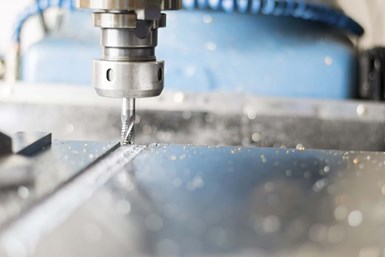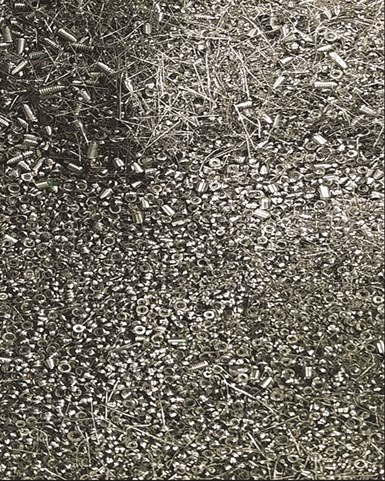Economics of Production Machining: Are You in the Speed or Feed Tribe?
Optimizing for multiple factors, not just minimizing cost for a single factor, will lead to profitable production machining.

The economics of production machining. Photo Credit: Getty Images
Production machining is a manufacturing domain where economics are the controlling factor. The jobs that we get are the result of our winning bid in an auction process. Factors such as ISO status, location and reputation all factor into the buying decision. However, the decision to buy from us almost always boils down to “lowest price.” Economically feasible production machining is based on achieving the lowest price to market. Our shops seldom have any real advantage in getting materials, supplies or tools at a lower cost than our competitors, so the cost of our manufacturing operations generally becomes the deciding factor.
Your shop’s tendency to be in the Tribe of Speed or the Tribe of Feed is the subject of this article. Because how you approach your machining operations can have a significant — perhaps dramatic — impact on the price you are able to offer. And, thus, the economic success of your shop.
Defining the Production Machining Process
The production machining process is an economic problem involving tooling costs, machining and operating costs, and material and nonoperating costs. As the material is specified to us by the customer, the choice of material is out of our control other than to no quote. So, the price of material is not really a factor in our current analysis. Similarly, nonproductive (nonoperating) fixed costs are baked into our manufacturing system and process, making them a nonfactor in our current analysis.
Tooling cost is a factor because it impacts our analysis as a function of speed. At higher speeds, more material is presented to the tool, causing more abrasive and frictional wear than at lower speeds. Abrasive wear is a function of the surface footage contacting the part — more footage equals more abrasion. Frictional wear is a result of higher cutting tool temperatures reducing the strength of the tool edge. Frictional heat increases with higher surface speed. It is this frictional heating that is responsible for the thermal failure of our cutting tools at higher speeds.
Frictional wear and frictional heat eventually degrade the performance of the tool, resulting in unacceptable surface finish and loss of dimensional conformance of the surface of the part, making it necessary to replace the tool. With higher speeds, more tools are required (and increased downtime to replace them!), so tool cost increases with increasing speed. While the cost to change and replace a tool is a constant for each tool, increasing speed creates increasing wear, requiring more tool changes. Tool cost is an important factor under our control — by finding an optimum speed that gives the maximum tool life.
The other side of this problem is the fact that the machining cost — the cost of labor and overhead — decreases with increasing speed. Increased speed minimizes time needed to drop a part complete. We need to balance the reduced times that increased (higher) speed gives us to produce the part against the decreased cost of tooling that decreased speeds delivers. (As a result of less wear due to lowered abrasion, friction and heat.) We need to determine the cutting speed that delivers the longest tool life and the lowest time to produce.
Between the conditions for lowest cost for tools and those that provide for the least amount of time to produce the part is a range of conditions that delivers both the longest tool life and greatest output. By minimizing tool consumption, while maximizing output over time, the shop achieves the most efficient use of all its resources.
Based on the material grade required by the customer (the grade determines the speeds and feeds available to the machinist), better tool life is obtained by using high feed and low speed rather than low feed and high speed. Less horsepower is required per cubic inch of metal removed, and fewer revolutions per minute are required. This reduces rubbing (abrasive and frictional wear) on the tool. To be fair, surface finish is not as good as feed increases, but operating at the feeds and speeds that deliver both an acceptable surface finish and maximize cubic inches of removal per unit time will result in the most acceptable parts at the end of the hour, shift, day and more.
The Tribe of Speed
The motto of the Tribe of Speed is “We don’t sell parts, we sell the time on our machines. Minimizing the time on our machines is the way to profits.”
I absolutely agree with the first sentence of this motto. We do sell the time of our machines used to make the part. We also sell the cost of the tools and the downtime as well as the materials needed to make the part. It is an oversimplification to say that the time to make the part is the sole determinant of our shop’s success — economic or otherwise — on a given job. The Tribe of Speed is interested in winning the race. It sees production of each part as a sprint to be won time and time again. While minimizing cycle time is one way of reducing cost of the finished product, it is neither the optimum way to reduce total costs nor to maximize production.
The Tribe of Feed
The motto of the Tribe of Feed is “What can I do that will get me the greatest number of compliant, shippable parts at the end of the day?” The tribe of feed isn’t into speed with its propensity to have more frequent — and more sudden — unexpected tool failures. The Tribe of Feed is interested in “steady as she goes.” The Tribe of Feed seeks predictable tool life, predictable uptime and predictable tool changes as the result of optimized parameters for all aspects of the machining process. Their approach takes into account tool life/tool cost, maximizing process uptime and minimizing unexpected downtime.
Fast speeds may win in a sprint, but this misses the fact that our provision of parts is actually a marathon. If the goal is most parts at the end of the shift or day, then the operating process that maximizes tool life and the number of parts made by each tool is our choice. If maximizing metal removal (the definition of our subtractive production machining process) is the goal, then balancing feed and speed to give us lowest tool cost and lowest cycle time is our best way forward. (See the sidebar for how one PMPA shop looked at their chips to learn their feed was too low.)
Defining ‘Winning’
Optimizing our processes for optimum and near steady state conditions can result in more parts per hour, shift, day and week than trying to reduce cycle time. Steady state can result in more predictable operations, lower downtime and more revenue for the shop. Steady state is achieved by balancing speed and feed to maximize tool life and uptime while maintaining minimal times to machine.
To which tribe do you belong? The Tribe of Feed? Or the Tribe of Speed? To which tribe does your engineering and shop culture belong? What about your sales team? Aligning everyone’s “membership” with the goals and objectives of the company might just be a way to improve working conditions, reduce costs and downtime, and increase revenues as well as attract more business.
Choose your tribe — wisely.
Feed Increase Saved Half a Shift of Time Over 18,000 Parts

Darrin Baker, 2nd Swiss Lead CNC Machinist at Pindel Global Precision, shared an experience on LinkedIn following his attendance at a session on “How to Read A Chip” at PMPA’s recent National Technical Conference. “Excellent example of reading chips and optimizing them… In the top left of the photo, you’ll see some conical chips created by a cutoff tool. With a quick change of feeds, you get the more tightly wrapped chips you see in the bottom half of the picture. The cones were very consistent, but the tightly wound ring is optimal.” (The cones are a clue that the speed is too high for the feed for that particular material.)
Read More Articles from PMPA:
- Thriving With You in 2022: Sharing Solutions
- Craftsman Cribsheet #108: OSHA Citations in FY 2021 for NAICS 332721 — Precision Turned Product Manufacturing
About the Author
Miles Free III
Miles Free III is the PMPA Director of Industry Affairs with over 40 years of experience in the areas of manufacturing, quality, and steelmaking. He helps answer “How?, “With what?” and “Really?” Miles’ blog is at pmpaspeakingofprecision.com; email – mfree@pmpa.org; website – pmpa.org
Related Content
Roles of Women in Manufacturing: What I Learned
Over 20 women were featured in the Roles of Women in Manufacturing series, which started in January 2023.
Read MoreCraftsman Cribsheet No. 129: How to Beat the Heat
Shops tend to heat up in the summer. Here are some tips for staying cool in the warmer months.
Read MoreCraftsman Cribsheet No. 126: AISI System of Identification
Source: PMPA Prior to the Society of Automotive Engineers taking responsibility for Steel Grade nomenclature in the United States (1995), the American Iron and Steel Institute determined U.S. standard steel grades in collaboration with SAE.
Read MoreCold-Drawn Steel Barstock: How It Is Manufactured, Benefits to Your Shop
Understanding the benefits provided by cold-drawn steel barstock can help you optimize the work you quote by maximizing benefits to your manufacturing process and customer.
Read MoreRead Next
A Tooling Workshop Worth a Visit
Marubeni Citizen-Cincom’s tooling and accessory workshop offers a chance to learn more about ancillary devices that can boost machining efficiency and capability.
Read More5 Aspects of PMTS I Appreciate
The three-day edition of the 2025 Precision Machining Technology Show kicks off at the start of April. I’ll be there, and here are some reasons why.
Read MoreDo You Have Single Points of Failure?
Plans need to be in place before a catastrophic event occurs.
Read More














.jpg;maxWidth=300;quality=90)







